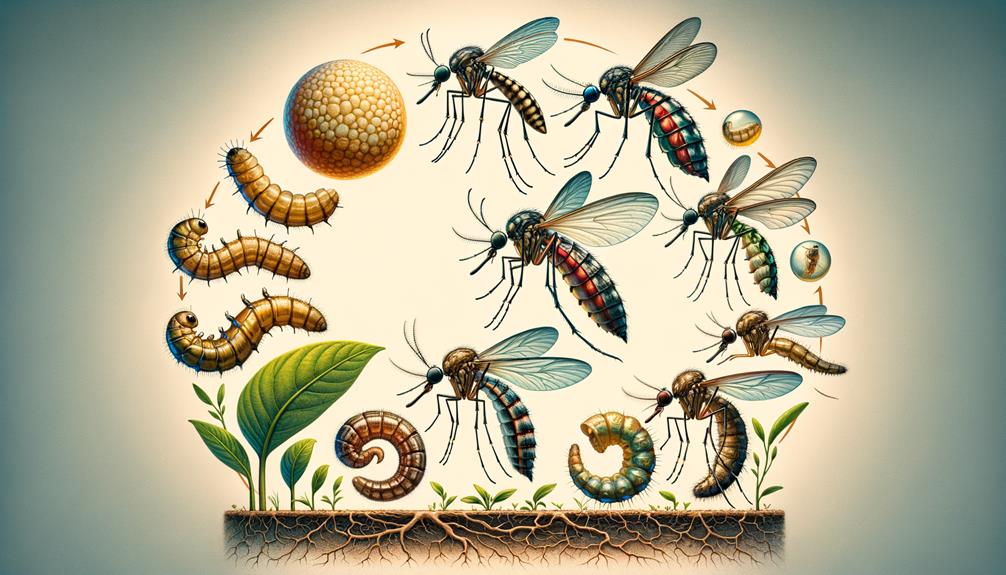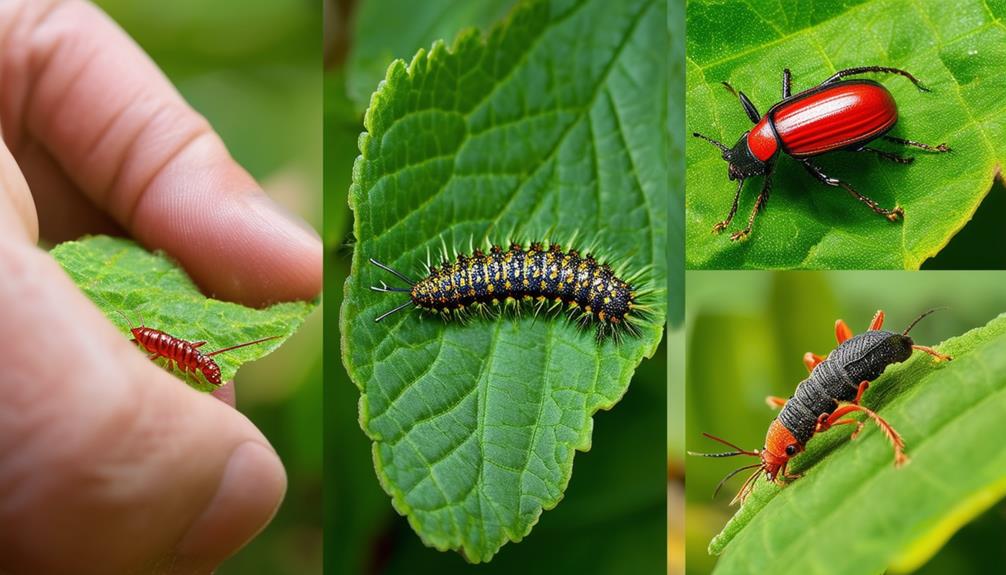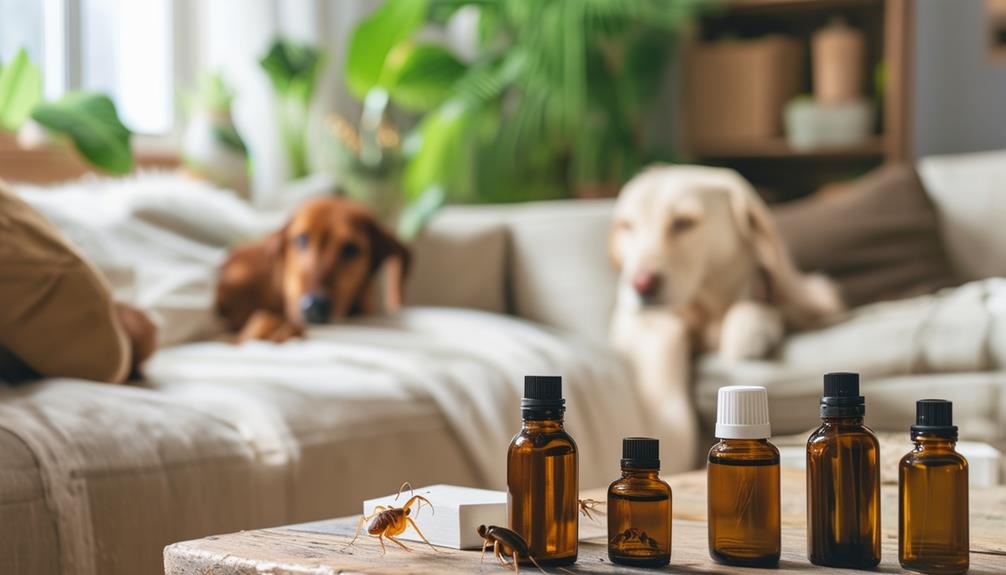Begin a journey through the life stages of mosquitoes. A female requires blood to lay eggs, resulting in larvae hatching in water. Larvae undergo molting, then shift into pupae. After metamorphosis, adult mosquitoes emerge. Eggs laid meticulously influence larvae growth essential for population dynamics. Larvicides manage larvae, interrupting growth for fewer adults. Pupae transform into winged adults, responsive to surroundings. Understanding these stages assists in effective control. Temperature, humidity, and food availability impact development. Lifespan varies by species, influenced by environmental factors. Control strategies concentrate on eliminating breeding sites to reduce populations, crucial for mitigation.
Key Takeaways
- Mosquito life cycle: egg, larva, pupa, adult stages.
- Female mosquitoes need blood meal to lay eggs.
- Larval stage crucial for population control.
- Pupal metamorphosis to aerial adults.
- Environmental factors impact mosquito development.
Mosquito Life Cycle Overview
The mosquito life cycle, comprising four distinct stages – egg, larva, pupa, and adult – unfolds with remarkable precision and adaptation to aquatic environments. Female mosquitoes play a pivotal role in this cycle, needing a blood meal to lay eggs. The process begins with the female mosquito laying eggs in water, which hatch into larvae within a few days. Larvae are aquatic and go through multiple molts before transforming into pupae. Pupae don't feed but instead undergo metamorphosis, preparing to emerge as adult mosquitoes. Once their body parts have hardened, adult mosquitoes take to the air.
Each stage in the mosquito life cycle serves a specific purpose in ensuring the survival and reproduction of these insects. Understanding these stages is essential in controlling mosquito populations and preventing the spread of diseases they may carry. The entire life cycle, from egg to adult, typically spans around two weeks, highlighting the rapid reproductive capabilities of these pests within suitable environments.
Mosquito Egg Development
Optimizing their reproductive success, female mosquitoes strategically deposit their eggs in locations conducive to hatching and larval development. Mosquito eggs are typically laid in rafts, floats, or on land that's likely to flood, guaranteeing a water source for hatching.
Female mosquitoes can lay hundreds of eggs at a time, increasing the potential for a large mosquito population. These eggs possess the remarkable ability to survive dry conditions, allowing them to remain viable until suitable hatching conditions arise.
The choice of egg-laying locations near water bodies is vital as it guarantees the availability of a suitable environment for the larvae to develop. The location where mosquito eggs are deposited plays a significant role in the overall development and survival of the larvae, ultimately impacting the population dynamics of mosquitoes in a given area.
Larval Mosquito Growth
In the developmental stage of larval mosquitoes, they undergo multiple moltings as they progress in their aquatic environment. Larvae, commonly referred to as wigglers, rely on these moltings to grow and develop. As they inhabit water bodies, larvae exhibit unique breathing mechanisms. They either utilize snorkel-like siphons to access air at the water's surface or position themselves horizontally to extract oxygen from the water. This adaptation facilitates their survival and growth during this critical stage of the mosquito life cycle.
Effective larval control is essential in the domain of Integrated Mosquito Management strategies. Larvicides play a crucial role in targeting and diminishing larval mosquito populations, thereby curbing the number of adult mosquitoes that can emerge. By focusing on larval growth and employing larval control measures, it's possible to disrupt the mosquito lifecycle and reduce the overall mosquito population in a given area.
Pupal Mosquito Transformation
During their metamorphosis from pupae to adults, mosquitoes undergo a substantial physiological transformation within their protective casings. Pupal mosquitoes, also known as tumblers, are in the stage just before emerging as adults. They don't feed and are motile, capable of moving in water. Pupae are highly sensitive to environmental conditions, reacting to changes in temperature, light, and nutrient availability.
This stage is pivotal in the mosquito life cycle, as it marks the shift from aquatic larvae to aerial adults. Inside their protective casings, pupae undergo a remarkable transformation, where their bodies develop structures necessary for adulthood, such as wings and specialized mouthparts for feeding. Understanding the pupal stage is essential for controlling mosquito populations, as disrupting this phase can have a significant impact on adult mosquito numbers and reduce the spread of diseases they carry.
Adult Mosquito Characteristics
Emerging from their pupal casings, adult mosquitoes exhibit distinct characteristics essential for their survival and reproduction. Female mosquitoes, requiring a blood meal to lay eggs, are the ones responsible for biting humans. Once their body parts have hardened, adult mosquitoes emerge onto the water's surface and take flight, ready to seek out a host. Understanding these adult mosquito characteristics is vital for implementing effective mosquito control strategies.
Let's explore the specific features of adult mosquitoes in the table below:
| Characteristic | Description |
|---|---|
| Female Mosquitoes | Require a blood meal to lay eggs, often seeking out humans as hosts |
| Body Parts | Harden after emerging from pupal stage, enabling flight and feeding |
| Adult Lifespan | Can live from 4 days to 2-4 weeks, varying by species and environmental factors |
Environmental Factors Impacting Mosquitoes
Considering the intricate interplay between temperature, humidity, and food availability, the environment profoundly influences the life cycle dynamics of mosquitoes. Environmental factors play a vital role in shaping mosquito populations and their behaviors. Here are some key points to understand how environmental factors impact mosquitoes:
- Temperature: Mosquito development is influenced by temperature, with warmer temperatures often accelerating their life cycle.
- Humidity: Adequate humidity levels are essential for mosquito egg survival and larval development.
- Food Availability: The availability of suitable food sources, such as nectar for adult mosquitoes and organic matter for larvae, directly impacts their growth and reproduction.
- Climate Change: Shifts in climate patterns, including milder winters, can lead to earlier mosquito emergence and extended breeding seasons.
- Overwintering: Mosquitoes have adaptive mechanisms to survive harsh freezes, ensuring their persistence in various environments.
Understanding these environmental factors is critical for effective mosquito population control strategies, especially in the context of climate change.
Mosquito Lifespan Considerations
In understanding mosquito lifespan considerations, the variation in longevity among different species and the influence of environmental factors play significant roles. The lifespan of adult mosquitoes can range from a mere 4 days to a relatively longer period of 2-4 weeks.
Environmental conditions greatly impact the development stages of a mosquito's life cycle. Favorable conditions such as warm temperatures and standing water can accelerate the progression from egg to adult, increasing the overall mosquito population. Additionally, milder winters contribute to higher mosquito populations in the spring, as some mosquitoes have the ability to overwinter successfully, even enduring harsh freezes.
Understanding these factors is vital in devising effective strategies for mosquito population control. By recognizing the impact of environmental factors on mosquito lifespan and development, researchers and policymakers can work towards implementing targeted measures to mitigate the growth of mosquito populations in at-risk areas.
Strategies for Mosquito Population Control
To effectively control mosquito populations, it's imperative to implement a combination of targeted strategies that focus on eliminating breeding sites and utilizing regular control treatments. Mosquitoes breed in standing water, and even small sources like potted plant bases can produce hundreds of mosquitoes. Hiring pest control professionals for larger breeding areas can aid in managing mosquito populations effectively. Regular mosquito control treatments, along with the removal of standing water, are key strategies for population control. By removing standing water, not only can mosquito populations be reduced, but the risk of mosquito bites can also be significantly lowered.
- Eliminate breeding sites like standing water to control mosquito populations effectively.
- Small sources of standing water, like potted plant bases, can breed hundreds of mosquitoes.
- Hiring pest control professionals for larger breeding areas can help in managing mosquito populations.
- Regular mosquito control treatments combined with removing standing water are key strategies for control.
- Removing standing water is crucial in preventing mosquito bites and reducing mosquito populations.
Frequently Asked Questions
What Is the Life Cycle of Mosquito Theory?
In the life cycle of a mosquito, you witness the marvel of insect metamorphosis. Larvae grow, pupa transforms, and adults emerge. Breeding habitats play an essential role in this intricate process, shaping mosquito development.
What Is the Natural Enemy of the Mosquito?
Dragonflies, fish like Gambusia and Koi, birds such as Purple Martins, Swallows, bats, spiders, frogs, and predatory insects all play essential roles as natural enemies of mosquitoes. Predator-prey relationships contribute to ecosystem balance through biological control methods.
At What Stage in the Life Cycle of the Mosquito They Are Considered Harmful?
In the life cycle of mosquitoes, the critical stage when they pose a risk due to biting behavior and disease transmission occurs when they reach adulthood. Understanding this significant phase is key for effective control methods.
How Can We Break the Life Cycle of the Mosquito?
To break the mosquito life cycle, you must focus on prevention methods like eliminating standing water. Environmental factors play a role in their reproduction cycle. Control larvae, destroy habitats, and address disease transmission to effectively reduce populations.





